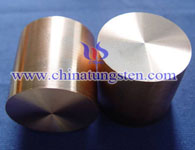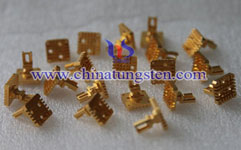Tungsten Copper Powder Metallurgy
What is Powderr Metallurgy?
Powder metallurgy is the process of blending fine powdered materials, pressing them into a desired shape or form, and then heating the compressed material in a controlled atmosphere to bond the material. The powder metallurgy process generally consists of four basic steps: powder manufacture, powder blending, compacting, and sintering. Compacting is generally performed at room temperature, and the elevated-temperature process of sintering is usually conducted at atmospheric pressure. Optional secondary processing often follows to obtain special properties or enhanced precision. The use of powder metal technology bypasses the need to manufacture the resulting products by metal removal processes, thereby reducing costs.
Powder metallurgy also manufactures objects and semi finished products from these powders and compounds, or from mixtures of these powders and compounds with nonmetallic powders, without melting the principal constituent.
Powder metallurgy involves producing metallic powders and preparing a mixture from them with a given chemical composition and specific processing properties; molding powders or mixtures made with them into semi finished products of a given shape and size, chiefly by pressing; and sintering, or heating the semi finished products at a temperature below the melting point of the metal as a whole or of its principal component.


Preparation of Tungsten Copper Powder Metallurgy
As the melting point of tungsten and copper vary greatly, tungsten melting point of 3410 ℃, much higher than the boiling point of copper and tungsten copper immiscible, so the tungsten-copper composite material prepared by powder metallurgy products out performance is much higher than the legal system prepared copper infiltration products. Further, the powder metallurgy method can improve the material's density.Tungsten copper powder metallurgy method is the choice of preparing fine tungsten, copper powder, soaked by the sintering process is refined class, can withstand high temperatures and nearly 2,000 high stress, with high melting point, high hardness, resistance to burning and good anti-adhesion resistance, electrical corrosion product surface finish, high precision, low loss. Preparation of alloy powder metallurgy method has good electrical and thermal conductivity, good high temperature strength and certain plasticity.
Tungsten Copper Powder Metallurgy Features
Powder metallurgy having unique chemical composition and mechanical, physical properties, and these properties are used conventional casting method can not be obtained. Using powder metallurgy technology can be made porous, semi-dense or fully dense material and products, such as oil bearings, gears, cams, guide rods, knives, etc., is a small non-cutting process.(1) Powder metallurgy technology can minimize the segregation of alloying elements, eliminating coarse, uneven casting organization. In the preparation of high-performance rare earth permanent magnet materials, rare earth hydrogen storage materials, rare earth luminescent materials, rare earth catalyst, high-temperature superconducting materials, new metal materials (such as Al-Li alloys, heat-Al alloys, super alloys, corrosion resistant stainless steel powder, powder high-speed steel, high-temperature structural materials intermetallic compounds, etc.) have an important role.
(2) Can be prepared amorphous, microcrystalline, quasicrystals, nanocrystalline and supersaturated solid solution and a series of high-performance non-equilibrium materials, these materials have excellent electrical, magnetic, optical and mechanical properties.
(3) Can easily achieve a variety of types of complex, give full play to the characteristics of each component material is a low-cost production of high performance metal matrix composites and ceramic technology.
(4) The production of ordinary melting method can not produce the materials and products with special structure and properties, such as the new porous biomaterials, porous separation materials, and high-performance structural and functional ceramic abrasive ceramic materials.
(5) Can achieve near-net shape forming and automated mass production, which can effectively reduce the production of resources and energy consumption.
(6) Can take advantage of the ore, tailings, steel sludge, steel mill scale, recycling scrap metal as raw material, is a material which can effectively carry out regeneration and utilization of new technologies.
Any feedback or inquiry of Tungsten Copper Alloy Products please feel free to contact us:
Email: sales@chinatungsten.com
Tel.: +86 592 512 9696 ; +86 592 512 9595
